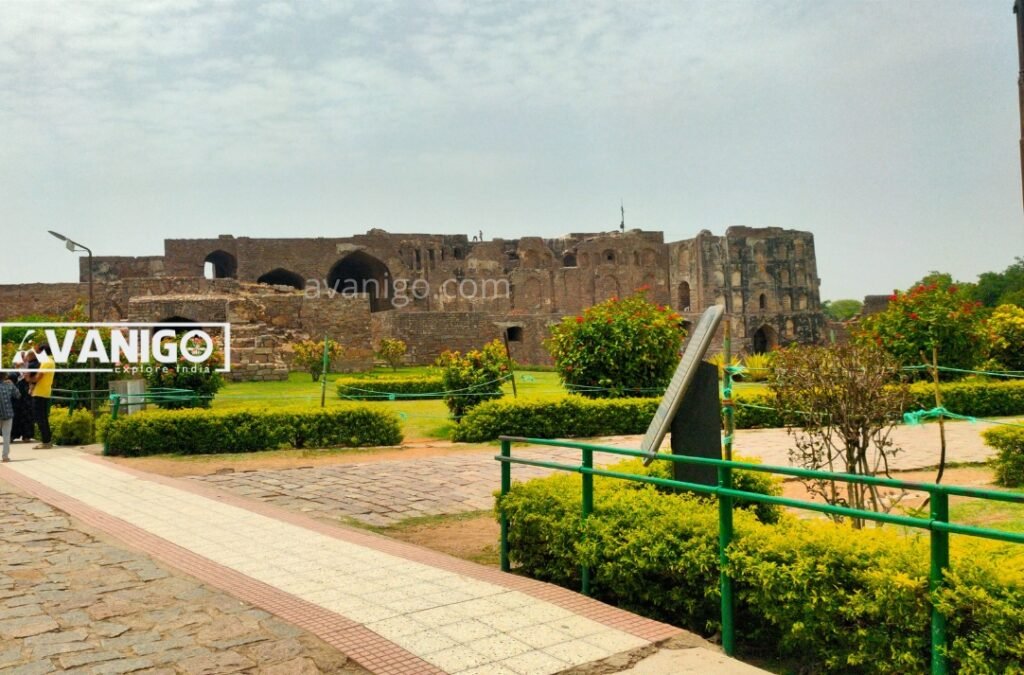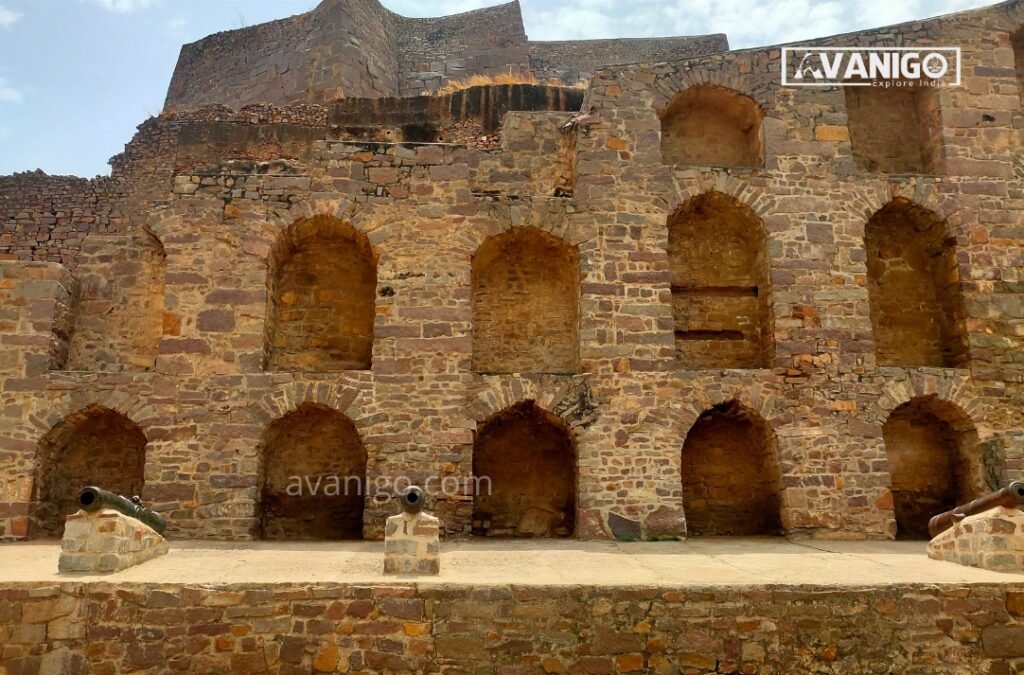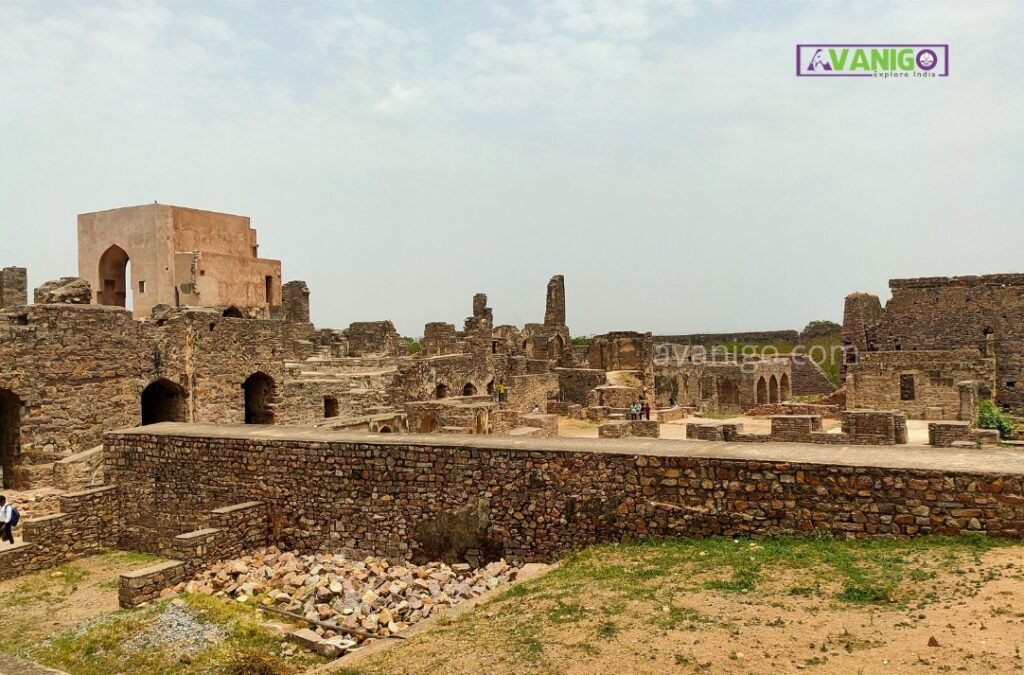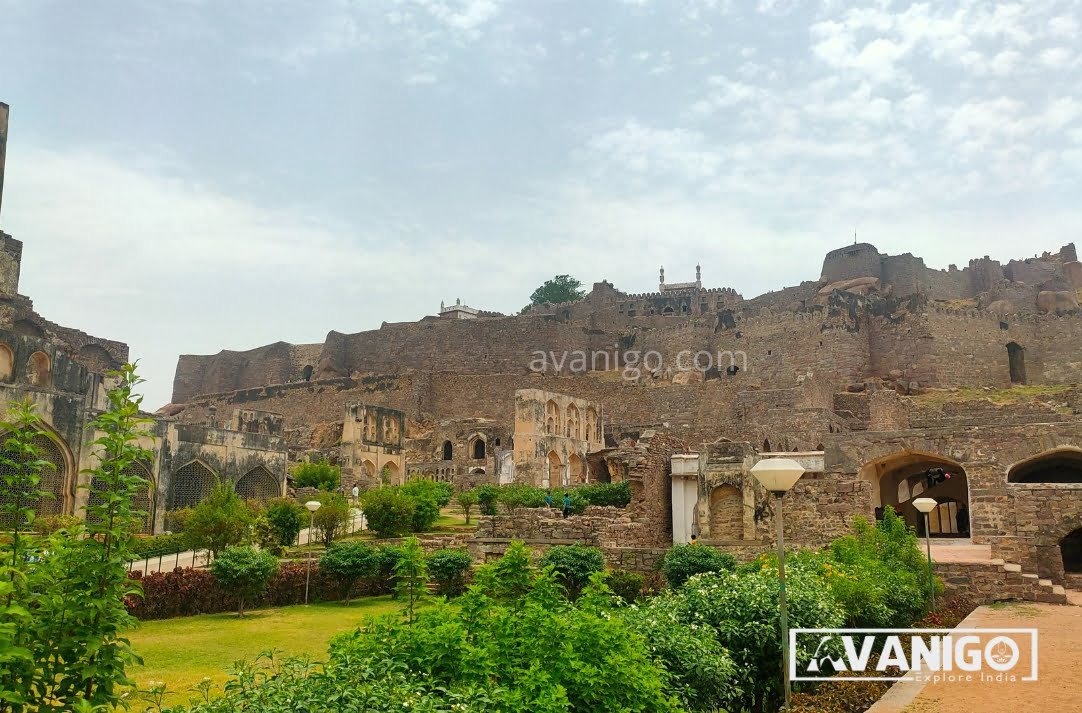Golconda Fort in Hyderabad is one of the best architectural jewels of India. It is on the city’s western side and still attracts tourists worldwide. Thanks to its jaw-dropping architecture that is still amusing, people from the last six centuries! The Golconda fort is famous for its advanced level of architecture and its acoustic features. The fort is also famous for its diamonds, such as Koh-i-noor. It is the best place to see in Hyderabad because of its stories, architecture, history, and mystery.
At Golconda Fort, every twist and turn is a new experience. So, let’s explore this pristine grandeur of India through its marvellous architecture.

Quick Navigation
Golconda Fort Architecture
Golconda Fort is standing tall on a 400-foot-high hill with a 7-kilometre circumference. It has a beautiful blend of Hindu and Islamic styles of architecture. The fort has 8 gates and 87 bastions, each between 50 and 60 feet tall. The area has 3 strong partitions: the first part is the town, the second part is around the base near the citadel gate, and the third part has the queens’ and princesses’ homes, as well as the homes of their guards, near the fortress.
Also Read: Angkor Wat Temple – The Eight Wonder of the World
The elegant gardens, 400 years old, may have lost the scent. Still, a stroll through these former gardens can take one’s in the Golconda Fort’s previous glory.

The Minarets of The Golconda Fort
Three of the fort’s 87 fortifications are especially remarkable. Alamgir’s commemorated with a large 16-foot-long cannon called Fath Raihbir, now housed in the Petla Burj minaret to the northwest of the fort. The cannon serves to emphasise the massiveness of the fort. Next comes the southernmost fortress, the Mosa Burj. The Azdaha Paikar is a perfect copy of the powerful Fath Raihbir that now stands in its place. The Majnu Burj is the final stronghold defended by the Alamgir Majnu cannon.

Also Read: Hyderabad Durgam Cheruvu Things to Do
The Remarkable Gates Of The Fort
1. Balahisar Gate:
Balahisar gate was for ‘Khas’ and ‘Aam’ guests. This piece of architecture is famous for its acoustic impact. The Curtain Wall, located opposite the main entrance, encircled the Balahisar gate, preventing any opponent from gaining enough space to breach it. Looking closely, one will see gaps in the gate’s arch. These gaps were to shower opponents with molten metal or boiling oil. The gate has iron spikes that keep elephants away from the fort, making Balahisar gate the ultimate defence.
Suggested Reading: Battle of Chandawar
2. Fateh Darwaza:
The most important gate is the last one, known as the “Fateh Darwaza” or the “Victory Gate.” It has iron spikes so that elephants can’t break it down. The Darwaza has an interesting sound effect: any sound made under the entrance dome can be heard at the Balahisar pavilion, the fort’s highest point. This was an excellent technique to inform people during the attack.
People think this effect comes from mixing materials with sound-reflecting properties into the building material intelligently. Today, people from around the world come to see this clever security measure of the Golconda fort and are amazed by it.
3. Citadel Gate:
An anticlockwise circle winds through gardens and relatively minor structures to the hill’s summit within the citadel gate. One can discover the Hindu Jagadamba Mahakali Temple and the three-story durbar chamber, which offers breathtaking views. The next descend to the historic palace structures in the southeast section of the fort and back to the entrance, passing the exquisite three-arched Taramati Mosque on the way.

Carvings On The Golconda Fort
The hallways and gates, nooks and corners, and every crevice of the Golconda fort have a tale to tell. Not only was it the treasury for some priceless gems, but it was also a shrine of tales with intricate engravings. Sculptures of legendary monsters protect the Balahisar gate of the fort. It is constructed with a pointed arch that has peacock sculptures and scrollwork. Even though its previous inhabitants belonged to the Mughal era, specific sculptures still reflect Hindu architecture, indicating its Hindu roots.
The Acoustic Architectural Wonder
Even a murmur from the hall where public gatherings were held or the hall where family and, on occasion, troops resided would reach the King’s bedroom. The intelligent wall construction and the doors’ precise spacing also contribute to this acoustic system’s effectiveness. With this setup, echoing from one end to the other doesn’t weaken the signal.

Other Amusing Parts Of The Golconda Fort
The Taramathi Gana Mandir and the Premamathi Nritya Mandir are the only pavillions in the Golconda Fort built on the rock. These are where the legendary sisters Taramathi and Premamathi lived. People say the two sisters performed on a circular dais at the top of the Kala Mandir building. One can see this from the top of the fort from the King’s court. This grand building has beautiful palaces and a unique water supply system.

There were no mirrors in the Queens’ rooms. Instead, there was a water pit. People thought that the Queens would get more dark spots on their skin if they looked at themselves in the mirror a lot. So, Queens looked at the reflections through the water pit. With its exotic designs, the fort’s ventilation is excellent. They were made so amazingly that a cool breeze could reach the inside of the fort and give a break from the summer heat.
Final Words
Some of the most interesting things about the Golconda fort architecture are its well-thought-out ventilation systems, water systems, and underground galleries. A thousand-step staircase leads up to the durbar hall, which has a view of both Secunderabad and Hyderabad. Anyone can be impressed quickly by the building’s beautiful style and mesmerizing construction.
At AvaniGo, we are passionate about India and its mesmerizing culture. We intend to share the greatness of Indian culture through our articles. To learn more about us and contribute to our website, email us at hello@avanigo.com.

